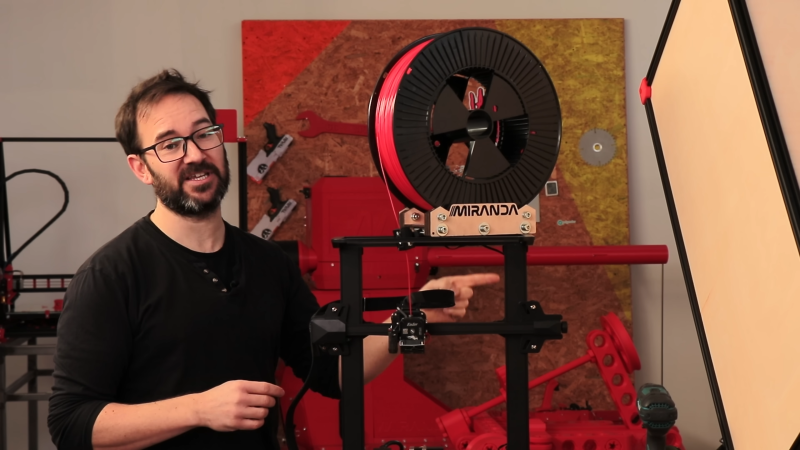Most 3D printers come with a pretty basic filament holder — often little more than a bar to hang the spool on. [Ivan Miranda]’s 3D printers run bigger spools than most, though, so he had to craft an altogether more serious solution.
Unlike most of [Ivan]’s creations, the spool holder isn’t actually 3D printed. For this job, he turned to a laser cutter instead, cutting the parts out of 5 mm plywood. A handful of layers of wood bolt together to form the frame. The frame holds several bearings for the outer rims of the spool itself to ride on, allowing it to spin freely as the extruder tugs on the filament. Reducing the rolling resistance of the spool is key when working with such large, heavy spools, and reduces the chances of the filament not feeding properly.
It’s a tidy example of a tool built quickly and easily using a laser cutter. It pays to remember that while 3D printers are great, a laser cutter can often turn out parts in a short fraction of the time.
















Ok, that will cause problems. It runs too smooth, meaning that if the printer gives a tug on it and then stops, the spool will spin more and the material will get a bit lose. Repeat this a bunch of times and then print and the filament will pull itself tight in a way where it can no longer properly unspool.
Learned this from experience at Ultimaker. You need some friction on the spool to prevent issues, making it unspool without any friction like this will cause more issues then it solves.
That makes sense, but because of how big it is, it seems less likely that it would ever be moving fast enough for that to happen. And since it’s so big, you might want it to be easy to get moving, to prevent too much tension on the filament potentially stretching it. *shrug*
It does, however, give you an opportunity to add a tensioning device that is independent of the spool weight; a bit of spring against a smooth part of the spool should do fine and let you dial it back to where the printer can consistently draw from it _and_ it doesn’t loosen. A tensioner on the filament itself attached to the holder could also prevent Z-height raises from reaching the spool, as well.
*loose
Thanks Andy. We were all stuck. You saved the day
I designed basically the same thing for 3kg spools, but 3d printed. It causes lots of problems with the Prusa MMU which does huge retractions when changing filament (buffer box is meh), but it does work well on my Prusa mini. Probably is a little problematic on brand new spools though even on the mini. I agree it’s not ideal. But I do like how simple it is.
Yeah, that amount of weight on top of a 3D printer is going to cause an issue. Maybe use this in conjunction with a pulley design?
Nice AD for his sponsor though.
Liked the laser enclosure, but for a job like this I would have considered CNC vs Laser.
Even a new standard spool will require you to adjust the bed level on a Ender style cheapy.
Frames are as flexible as a lawyer’s/politician’s/preacher’s morals.
This design has been around for ages. At least a half a dozen variants of it available on the various 3d model sites. Absolutely nothing new here.
Comically large spools of filament
The name, Miranda, caught my eye and had he made the filament spool look like the Blue Sun there would have been no question he was a Browncoat.
As was mentioned, a free willing, I mean free wheeling rotation is not ideal and some friction should be introduced. Or else the Reavers will step in a make a real mess.
Seems like a standard saw/scroll saw/band saw and a drill would work just as well for this project :) .
Neat idea though.
darn,was hopeing for industrial size spools,forklift or crane
size
proly could gear something up useing spools of 2″ polyethelyene rope as print media,which does come in
10ton rolls,use a trolley crane for x,y,and z,lots of those
run off wireless controls now….print REAL big
Had one of these for about 5 years now, 3D printed version with skateboard bearings in it. Had no problems with it overpulling as there is a little bit of resistance and also is mounted on a shelf far higher than the printer so is less affected by big X axis movements… My regular sized spools are all wall mounted on metal bars with some simple brackets I designed too (darknrg on thingiverse for the design)
I have my filament mounted horizontally on my printer and then I run the filament through the spool hole. Very little resistance as the spool just unwraps itself.